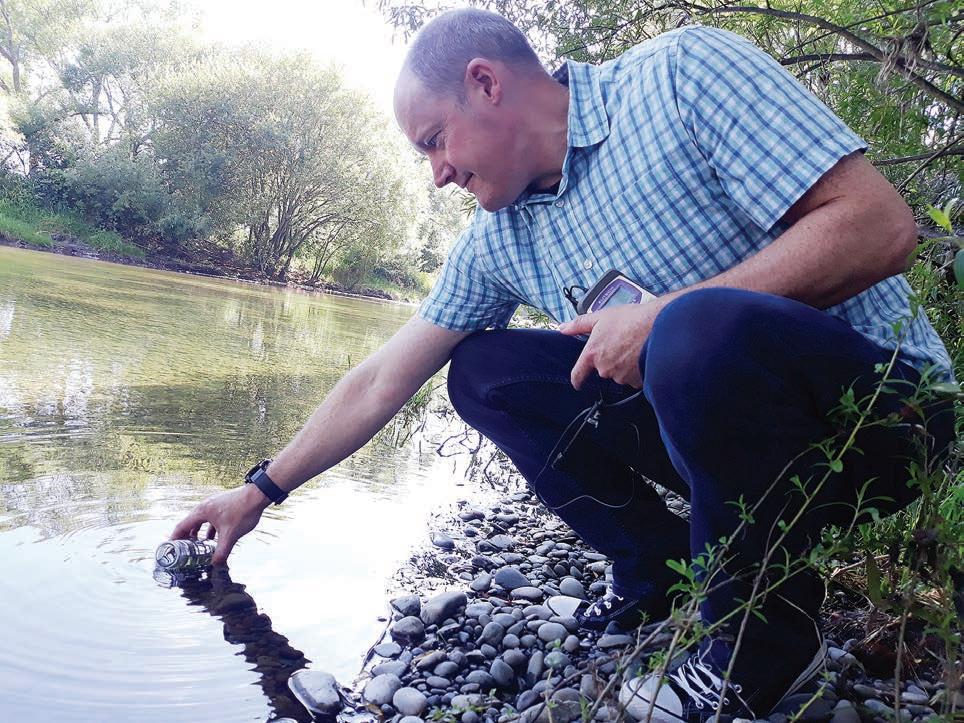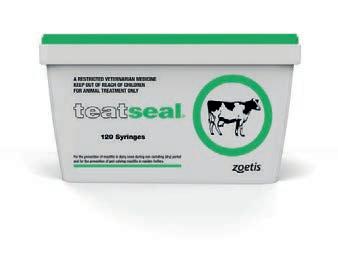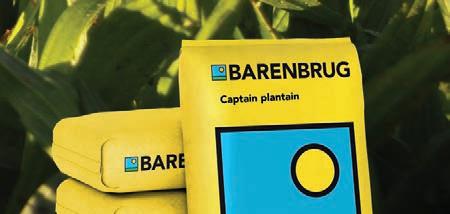
15 minute read
Research
from Dairy Farmer February 2021
by AgriHQ
Milk packs punch against flu
By Gerald Piddock
We already know milk is good for the bones, but now research shows that drinking milk could help ward off the flu.
New research has found that a protein-based ingredient from milk is an effective antiviral agent against a common influenza virus species.
The study commissioned by New
Zealand company Quantec, and completed by an independent US laboratory, found that Immune Defence
Proteins (IDP) was 120% more effective against the virus Influenza A when compared to the protein lactoferrin.
Testing on the herpes simplex virus netted a similar result.
The study showed that IDP’s formulation, which contains over 50 bioactive proteins, provided greater antiviral activity than lactoferrin, which contains a singular protein.
Lactoferrin was used as a comparison in the study because studies have shown it to have antiviral activity.
Influenza A is a virus commonly implicated with flu occurrences, and herpes simplex is implicated in the causation of cold sores.
In the testing, IDP achieved IC50 2 based on 9.7mg/ml compared to
Lactoferrin’s 21.8mg/ml, making IDP twice as powerful.
IC50 is a way of defining the potency of a substance by scientists. This result showed it would take 21.8 mg/ml of purified lactoferrin to be as effective as 9.7 mg/ml of IDP.
Quantec founder Dr Rod Claycomb says the results suggested that IDP could play an important role in protecting cells from influenza or herpes infections.
“These are exciting results for IDP and they support our ongoing development of new products, based on the benefits provided by the powerful synergy in the
IDP complex.
“Nature created the bioactive proteins in milk to work together with the body’s microbiome to support the immune system,” Claycomb says.
“We continue to extend our knowledge of the benefits of the IDP protein complex and its application to support immune health.”
He says rather than killing the virus, it halts its progress by creating a barrier.
Established in 2009, Quantec has developed, manufactured and commercialised IDP, which contains over 50 bioactive proteins that occur naturally in milk to protect the cow from infection and inflammation.
Quantec patented the discovery that IDP’s proteins have significantly higher bioactivity than that of singular milk proteins, such as lactoferrin.
The compound has already been proven to have anti-inflammatory,
Quantec founder Dr Rod Claycomb says rather than killing the flu virus, Immune Defence Proteins halt it. antioxidant and antimicrobial properties.
These properties make IDP particularly effective as an active ingredient for functional skincare and dietary supplements, due to its ability to work topically on the skin, oral and gut surfaces, Quantec chief executive Raewyn McPhillips says.
“At Quantec we produce and market supplement ranges that feature IDP such as Milkamune, suitable for adults and children, and the skincare range Epiology, which uses IDP to prevent the spread of acne-causing bacteria,” she says.
“IDP is also used as a key ingredient for food and beverage products in the form of powder sachets, protein beverages and chewable tablets that are currently sold in China and other Asian markets.
“A key part of our approach to grow Quantec is to work with strategic partners in key markets. Our 20-year agreement with China-based Holon, a significant player in the Chinese supplement market with their brand Laitap, is an example of this.”
Claycomb says their next step will be to test IDP on more viruses including covid-19. He also plans to begin clinical trials on humans in 2021. n

Farmers’ work far from done

be in much worse condition if farmers hadn’t improved their practices over the past 20 years, according to research findings released recently by Our Land and Water National’s (OLAW) Science Challenge.
Without the mitigation efforts, scientists estimate between 1995 and 2015 there would have been 45% more nitrogen and 98% more phosphorus going into our waterways.
They say this has mainly been achieved through excluding stock from streams, improved effluent management and improved irrigation practices.
That’s the good news. The bad news is at least 43% of NZ’s agricultural land is in catchments that are under pressure from excess nitrogen, meaning more needs to be done to remedy this.
But researchers say that can be turned implemented by all farmers, nitrogen entering rivers would decrease by 34%, Fencing streams and keeping stock out of waterways
By Tony Benny
Farmers are working harder than ever and putting good practices in place to ensure New Zealand’s water quality improves.
New Zealand’s rivers would
around within 15 years, and if all known Our Land and Water chief scientist Professor Richard McDowell says mitigation and developing mitigation actions were efforts have helped improve New Zealand waterways. has helped water quality, but more work is needed. phosphorus by 36% and sediment by 66% investigated the impact on water quality in 1995 and 2015, and what would be compared to 2015. For many catchments, of adopting better practices on dairy, possible for future water quality in 2035 this would be enough to meet current sheep and beef farms. if every farm in NZ adopted every known water quality objectives. The researchers wanted to understand mitigation.
OLAW, one of 11 National Science how effective on-farm mitigations have This information is crucial to helping
Challenges that fund research aimed at been so far, by comparing losses of farmers in degraded catchments to solving NZ’s biggest problems, recently nitrogen, phosphorus and sediment decide whether to continue investing

in mitigation actions or consider making changes to land-use or land-use intensity.
“When we look at adopting all the established mitigations that we have now, most NZ catchments can get most of the way towards meeting the current water quality objectives,” OLAW chief scientist professor Richard McDowell says.
Despite the efforts of many farmers to care for our water, nitrogen loads have increased over the past 20 years because other farms have changed or intensified their production.
Land area used by dairy expanded 40% between 1995 and 2015, and total dairy production increased by around 160%. The land area occupied by sheep and beef contracted, but the intensity of production per hectare increased.
“Aotearoa’s freshwater quality is degraded, and in some areas much more than others,” he says.
“However, the current situation is much better than it would have been if no action was taken while the same increase in food production occurred.”
Just where nitrogen concentrations are heaviest and how that picture would change if all farmers adopted all on-farm mitigations to reduce nitrogen loss to water can now be seen on an interactive map available online (tinyurl.com/OLWmap), also funded by OLAW’s National Science Challenge.
“This map helps New Zealanders see where meeting limits is achievable, and where limits aren’t likely to be met under existing land use,” he says. n Map of New Zealand, showing where nitrogen concentrations are highest. The dark red shows the highest. With the interactive online map, users can drag the slider to the left to see where rivers are under the greatest pressure from nitrates and to the right to see what

PROTECTING THE FUTURE OF YOUR HERD.

would happen if all mitigations were adopted by all farmers.

THAT’S GOT THE TEATSEAL OF APPROVAL.

Keeping your herd healthy and productive is a 365 day a year job, and dry off is one of the most critical times to prevent mastitis. What you do (or don’t do) during dry off impacts herd health and sets up your cows for future seasons. Teatseal® is proven as the most effective way to prevent new infections, both over the dry period and at calving.
By preventing mastitis with Teatseal, you’ll be one step closer to making dry off pay off. Contact your vet or learn more at teatseal.co.nz

AgResearch senior scientist Dr Val Snow says research has shown urban people have a greater awareness of the value of agriculture because of covid-19.

Pandemic’s silver lining
By Anne Boswell
New research has found a positive to come from the covid-19 pandemic is the contribution farmers make.
The recognition of farmers’ standards of living that agriculture contribution to New Zealand’s provides plentiful safe food and fibre.” food production system has The study, conducted by AgResearch been identified as a positive scientists, New Zealand Institute of aspect of the covid-19 pandemic Economic Research (NZIER) and several experience, according to a new study science organisations in NZ and released by AgResearch. Australia, surveyed farmers and others
One farmer experienced “a change working in the agriculture and food in attitude among the public around systems in Australasia about the impacts how they value the security of food of covid-19 in the period through to production and therefore the role of June 2020, which included national farmers in providing that food.” lockdowns.
Others noted “NZ agriculture is AgResearch senior scientist Dr Val starting to be seen as an important Snow says that while the survey and cog in the mechanism again,” “greater interviews did not specifically ask about recognition of the true value of public attitudes or appreciation for the agriculture and primary producers,” agri-food sector, a number of people and “governments and communities did comment that the pandemic and recognised the importance to our response to it has resulted in a noticeable positive change in how their work was perceived.
“There is certainly a view that one positive effect has been a greater awareness in the non-farming communities of both NZ and Australia of the critical value of food and agriculture in maintaining social function,” Snow says.
Although study participants acknowledged overall negative effects, additional stress and pressures from the pandemic and response, only 47% of NZ survey respondents viewed the effect on their farms or businesses as negative over that period. A further 37% says the effect was neutral.
Overall, the study found that “to June 2020, the impacts of the covid-19 control
measures on the agri-food sectors in both Australia and NZ have been relatively small and that this has been due to the high levels of resilience in the agricultural systems and the people running them.”
“The term resilience is a buzzword that’s probably a bit overused, but it’s clear from our analysis that the in-built ability to cope with adversity through various means, find new ways of doing things and get on with the job, were important in how farmers and their supporting industries performed so well,” Snow says.
“Many farmers were already dealing with drought conditions, but were able to manage through the extra difficulties. We’ve seen those in other countries not fare as well.”
She says relatively high technology use and strong connections in the NZ sector also meant it was well placed to respond to the pandemic.
The study also illustrated that not only has the agricultural industry survived the pandemic so far, but has found several positives in the experience, too.
Much of NZ’s primary sector was able to continue working through the covid-19 lockdowns, and overseas demand for its products stayed strong.
Its financial performance was positive, with export revenue from primary products for the period exceeding revenue from the previous year.
Those interviewed in the NZ sector also identified benefits such as better ways of working, including going paperless or conducting online meetings and opportunities for new markets for their products.
One Kiwi farmer says the necessity to home-school the kids “meant they were involved in farming life and saw the decision-making process and us discussing real life events.”
“Some Kiwi farmers found being required to stay on their farms through covid-19 restrictions meant they were actually more focused on their core tasks and their family life,” she says.
While farmers have fared well so far, researchers anticipate a follow-up study in 2022 to see if and how those impacts have changed over time.
“It is not yet clear if the current resilience mechanisms can persist under the continued onslaught of the virus. We indicate the need to capture longer term effects and analysis during the more sustained effects of the virus and through a recovery period, ” the paper notes.
Snow says although the outlook is more positive now with access to vaccines looming, many of those we heard from expect impacts of the pandemic to linger for some time. n

Keep your system MILK-READY

Don’t just clean your system
Make sure you get it Milk-Ready for the next milking. Our range of detergents will help you to make sure your system is ready to extract, transport, cool and store the highest quality milk.


Genomics promises better grass
Imagine you could double the rate of genetic improvement in your dairy cows – how much of a difference might that make to farm sustainability, efficiency and production?
Now, imagine plant breeders could do the same with the one species of pasture that feeds more New Zealand dairy cows than any other.
This will be the commercial reality in a few years, thanks to pan-industry scientific collaboration and latest advances in DNA-based plant selection.
This autumn, as you’re sowing new pasture on-farm, scientists and breeders based in Canterbury will be sowing up to 50 potential new perennial ryegrass cultivars created using genomic selection (GS).
It’s the third year of a large-scale commercial effort to validate the use of
GS for more accurate selection of new grasses. Those involved say results so far are encouraging.
“Proof of concept has been achieved.
We are now using this technology as part of our commercial breeding,” Barenbrug
NZ plant breeder Will Clayton says.
Along with AgResearch, DairyNZ,
Beef + Lamb NZ, Deer Research, Dairy
Australia, Grasslands Innovation and the Ministry of Business, Innovation and
Employment (MBIE), Barenbrug is part of
PG+ (formerly Pastoral Genomics).
This consortium is developing technology to help seed companies breed better ryegrass and clover varieties faster, so farmers can reap the benefits sooner.
A key target is to accelerate genetic gain in perennial ryegrass yield from the current rate, estimated to be 0.8% a year, to 2% a year.
Scientists sequencing perennial ryegrass DNA have already linked
DNA-marker combinations to DM yield, allowing them to assign an estimated breeding value (EBV) for yield very early in the breeding process, using leaf samples taken from seedlings only a few weeks old.
But before this technique can be deployed commercially, it must be Barenbrug NZ plant breeder Will Clayton says early results from genomic selection are encouraging.

“Proof of concept has been achieved. We are now using this technology as part of our commercial breeding.” Will Clayton
validated against results of traditional, phenotypic plant breeding, to make sure an EBV for yield holds true when compared to real-world plant performance.
So far, so good, Clayton says of their progress.
“The plant selections we’ve made based on GS have been on a par with, if not better, than those based on phenotypic selection,” he says.
What does that mean for farmers? Quite a bit.
Increased speed and accuracy provided by GS could shorten the 1215-year breeding and selection process currently required to improve plant performance.
By genetically screening promising new plants as seedlings, breeders can create and evaluate multiple generations of new crosses without having to wait for them to grow to mature plants, and be evaluated by years of grazing, harvest and disease screening as is the current status quo.
This in turn would compress the existing timeframe from first cross to commercial seed, perhaps by up to half, without compromising critical on-farm testing and agronomy trials nationwide to prove pipeline cultivars will perform and persist, prior to release.
Clayton says the beauty of GS is that yield is only one of many traits for which genetic gain in perennial ryegrass could potentially be fast-tracked.
Others that have already been investigated by AgResearch include heading date, and a wide range of nutritional attributes, including water soluble carbohydrates (WSC).
“Currently we’re validating GS for yield, because yield is easy to measure. But the plan is to also look at other factors, including persistence, feed quality, disease resistance, nitrogen use efficiency and water use efficiency,” he says.
Barenbrug science manager Colin Eady says the promise of GS must be balanced against commercial risk.
“Our existing breeding process is not broken – it produces brilliant cultivars by skilled breeder knowledge and efficient robust techniques that follow the KISS principle,” Eady says.
“GS requires high throughput trait analysis, huge computing resources, complicated computational scripts, outsourcing processes and skilled bioinformaticists – which is a huge Leaf sampling for genomic selection.
change to how we have traditionally done things.
“Making sure it is robust, IP is protected and commercially viable requires years of beta testing and planning. Changing the bathwater without throwing out the baby is more complicated than you might imagine.” n


Morrow MS red clover

Morrow multi-stemmed (MS) red clover’s high stem number gives improved grazing tolerance, with its deep tap root delivering high summer-autumn yield.


Captain CSP plantain Captain CSP plantain

As well as reducing N leaching, Captain cool season plantain (CSP) has more growth in this period - the most valuable feed in farm systems.










